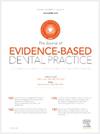口腔健康和疾病的个性化概况:使用高维矢量模型来指导精确的牙科护理
IF 4
4区 医学
Q1 DENTISTRY, ORAL SURGERY & MEDICINE
引用次数: 0
摘要
口腔健康经验的操作化是一项持续的努力,各种临床和患者报告的结果有助于这种概念化。计算技术在模拟各种现象之间复杂相互作用的能力方面取得了进展,并提供了重新考虑口腔健康概念化方式的机会。本文介绍并讨论了高维向量空间建模作为一种理论方法来整合与理解口腔健康相关的所有相关特征,包括临床、患者报告和人口统计信息。具体而言,本文提出了一种新的应用高维向量空间模型作为载体来实现口腔健康的3P模型。此外,本文概述了这种方法如何能够1)创建更精确的,个人层面的口腔健康特征;2)长期跟踪口腔健康,为行为干预提供更大的机会,以预防、减轻或治疗牙齿、口腔和颅面疾病的负面影响;3)对动态调整的比较向量进行比较,这些比较向量可以定义“良好”的口腔健康,并量化差异和特征,以便进行干预以减轻它们。本文章由计算机程序翻译,如有差异,请以英文原文为准。
PERSONALIZED PROFILES OF ORAL HEALTH AND DISEASE: USING HIGH-DIMENSIONAL VECTOR MODELS FOR GUIDING PRECISION DENTAL CARE
Operationalizing the oral health experience is an ongoing effort with various clinical and patient-reported outcomes contributing to such conceptualizations. Computational technology has afforded advances in the ability to model complex interactions between various phenomena and provides an opportunity to reconsider the way oral health is conceptualized. High-dimensional vector space modeling is introduced and discussed as a theoretical way to incorporate all relative features associated with understanding oral health, including clinical, patient-reported, and demographic information. Specifically, a novel application of high-dimensional vector space models is proposed as a vehicle to operationalize the 3P model of oral health. Additionally, this paper outlines how this approach can 1) create more precise, person-level characterizations of oral health; 2) track oral health over time, offering greater opportunities for behavioral interventions to prevent, mitigate, or treat the negative impacts of dental, oral, and craniofacial diseases; and 3) offer comparisons to dynamically tuned comparison vectors which can define “good” oral health and quantify disparities and features on which to intervene to mitigate them.
求助全文
通过发布文献求助,成功后即可免费获取论文全文。
去求助
来源期刊

Journal of Evidence-Based Dental Practice
DENTISTRY, ORAL SURGERY & MEDICINE-
CiteScore
6.00
自引率
16.70%
发文量
105
审稿时长
28 days
期刊介绍:
The Journal of Evidence-Based Dental Practice presents timely original articles, as well as reviews of articles on the results and outcomes of clinical procedures and treatment. The Journal advocates the use or rejection of a procedure based on solid, clinical evidence found in literature. The Journal''s dynamic operating principles are explicitness in process and objectives, publication of the highest-quality reviews and original articles, and an emphasis on objectivity.
 求助内容:
求助内容: 应助结果提醒方式:
应助结果提醒方式:


